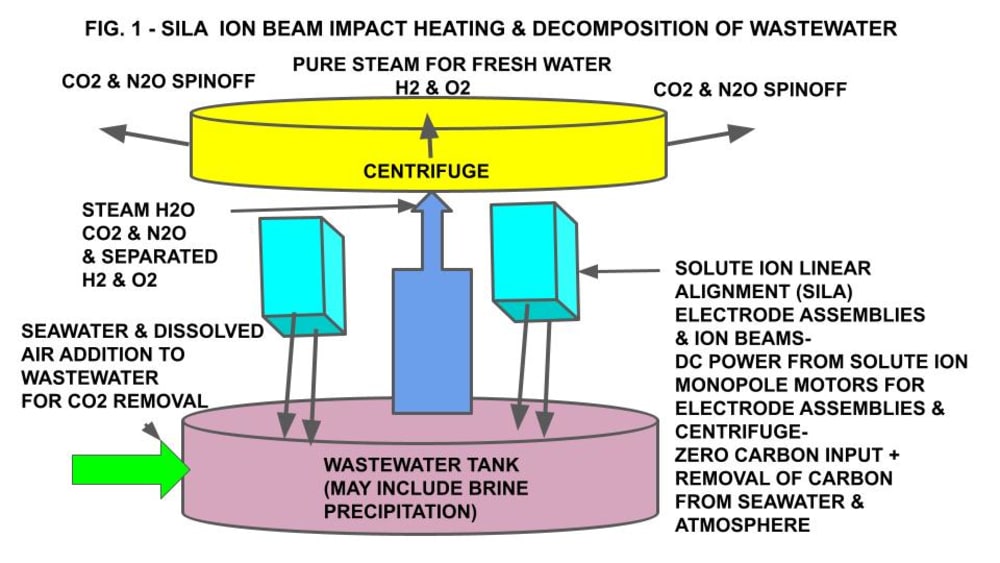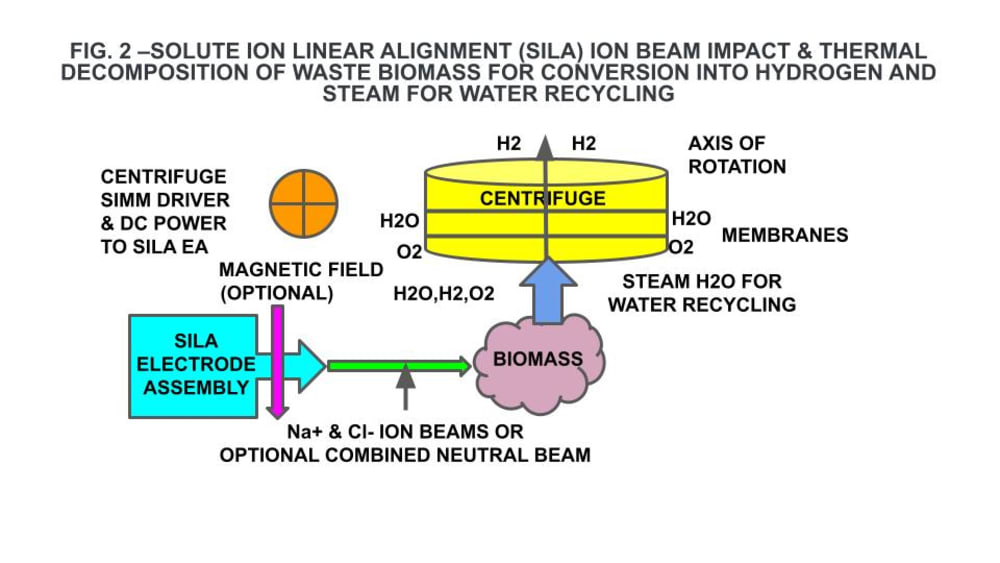Solute ion linear alignment (SILA) can be applied to treat wastewater while at the same time reducing CO2 emissions and desalinating sea water. It can also be used to thermally decompose biomass into H2 and O2 and extract water
SILA generates energy from repulsion forces between like-charged ions that are accumulated in the capacitive deionization process (CDI).
Repulsion forces are based on Coulomb's Law and the electrostatic fields that are continuously radiating from the ions.
SILA has been previously illustrated in these websites:
http://contest.techbriefs.com/2012/entries/sustainable-technologies/2589
http://contest.techbriefs.com/2014/entries/sustainable-technologies/4465
(Includes magnetic-field-separation)
http://contest.techbriefs.com/2020/entries/medical/10431
http://contest.techbriefs.com/2021/entries/Electronics-Sensors-IoT/11174
Referring to FIG. 1: SILA ION BEAM IMPACT HEATING & DECOMPOSITION OF WASTEWATER, sea water with dissolved air is added to wastewater that is pumped into a Wastewater Tank. SILA Electrode Assemblies (EAs) are positioned above the Wastewater Tank so as to inject ion beams of, e.g., sodium and chlorine into the wastewater.
The wastewater temperature is thus raised to the boiling point and some of the wastewater H2O is separated by the ion beams into H2 and O2 gasses. The vapor can therefore contain Steam H2O, H2, O2 and both CO2 that was dissolved in the sea water and N2O originating from the wastewater.
Based on their differences in atomic and molecular weights, these gasses can be separated in a Centrifuge.
A solute ion monopole motor (SIMM) which does not require external input power but instead relies on the electrostatic repulsion of like-charged solute ions as the driving force can provide DC power to the SILA EAs and also provide power for operation of the centrifuge.
Therefore, there is Zero Carbon Input and Removal of Carbon from the sea water and the atmosphere.
Referring to FIG. 2, SOLUTE ION LINEAR ALIGNMENT (SILA) ION BEAM IMPACT & THERMAL DECOMPOSITION OF WASTE BIOMASS FOR CONVERSION INTO HYDROGEN AND STEAM FOR WATER RECYCLING
Solute Ion Linear Alignment (SILA) Electrode Assembly (EA) is provided which can accelerate solute ions such as sodium Na+ and chlorine Cl- via the solute ion linear alignment process to speeds potentially near the speed of light, c.
A magnetic field can be applied to cause the ion beams to converge into a generally neutral ion beam. The neutral ion beam is then caused to impact waste biomass.
The biomass and the water contained therein can thereby be caused to convert into Steam H2O and separated Hydrogen H2 and Oxygen O2.
The Steam H2O and separated Hydrogen H2 and Oxygen O2 can be directed into a Centrifuge which includes Membranes so as to first prevent flow of the heaviest component Oxygen O2 mol.wt. 32 gms/ mol, then Steam H2O mol. wt. 16 gms./ mol, followed by Hydrogen H2 mol. wt. 2 gms/mol.
A Solute Ion Monopole Motor SIMM can be utilized to rotate the Centrifuge around its Axis of Rotation as described for FIG. 1.
The SIMM can be utilized with a Generator to provide DC power to the SILA EAs or SILA EAs can be utilized to provide electrical power.
Like this entry?
-
About the Entrant
- Name:Anthony Fresco
- Type of entry:individual
- Patent status:patented





